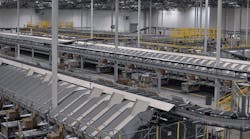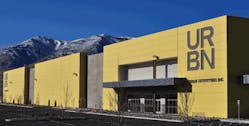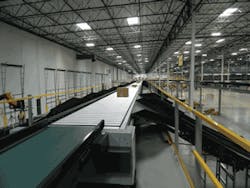You can't be a brick-and-mortar retailer and not have Amazon on your mind. Even its competitors acknowledge that Amazon has set the bar for the speed-to-market concept with its proliferation of fulfillment centers from coast to coast. Ken McKinney is aware of those capabilities, but he's even more aware of his customers' capabilities to map their own logistics future. As executive director of logistics at Urban Outfitters, that thought hit him a few years ago when he realized that California represents this retailer's number-one market for web orders and it was still taking four to five days to get product to customers there from its Trenton, S.C., distribution center. That's why Urban now serves that market out of the most recent addition to its DC network, located in Reno, Nev.
The addition of this, its second Internet fulfillment DC in the U.S. (third overall, including a DC in the United Kingdom), means this apparel and home goods retailer can now service close to 80% of its customers within a two day ground transit time. In addition to these Internet fulfillment centers, the company operates two U.S. (Gap, Pa., and Reno, Nev.) DCs and one U.K. DC that service its retail stores.
McKinney acknowledges that competitors like Amazon and Zappos have raised the logistics service bar for what customers expect from Urban Outfitters, whose brands include Urban Outfitters, Anthropologie, Free People, BHLDN (pronounced Beholden) and Terrain.
Young Customers, New Demand
"Customers for the Urban brand range in age from 18 to 25, a very savvy demographic," he says. "They expect fast service on their orders, and as a company we make every effort to meet those expectations."
If an item is out of stock in one of the company's DCs, it has the capability of fulfilling the order from the inventory in one of its stores. On any given day, 7-10,000 orders can be fulfilled in this manner across all of its brands.
"We have realized substantially more revenue since introducing this capability," he says. "That said, the most efficient method of fulfilling a customer order is unquestionably via the DC network."
Filling the DC Gap
That's why Urban is following up its Reno project with a brand new DC that just broke ground in Gap, Pa. With this new facility, Urban will be able to deliver to its New York customers in a day. This investment was made more for service considerations than for the hope of achieving a quick system ROI, thus supporting the growth of its DC network.
"Internet sales account for roughly 25% or our revenue, and that number is increasing," McKinney adds. He points out that fulfilling customer orders is a markedly different process than sending merchandise to the stores. "In terms of productivity, we measure units per manhour in our retail DCs and we measure orders per man hour in the direct-to-consumer operations. Direct is so much more labor intensive because every two to three units (the average order size) you're either sealing a box or a bag. Add to this the task of processing customer returns and we're talking a significant delta between the retail store DCs and the internet DCs."
Urban has adopted the campus concept for its distribution operations, with one site supporting both retail and direct-to-customer channels. It is working with warehouse automation supplier Vanderlande (www.vanderlande.com) on this, the third of its U.S.-based DC projects. The Reno project applied the same principles as the model initiated in the company's United Kingdom operations.
Driving a Hybrid Distribution Project
The concept is dubbed a "hybrid," including a crossbelt sorter for the direct business, and a put-to-light packing solution in the retail operations servicing the needs of 400 stores.
"We've become enamored with the idea of the campus concept because it enables us to flex our labor back and forth between buildings," McKinney explains. "Those businesses don't peak at the same time; retail peaks a few weeks ahead of direct, and having the ability to deploy labor across channels is a key advantage, one that we enjoy in the U.K. and Reno and that we will have in Gap."
Andy Williams, business development manager for Vanderlande, explains that the technology side of this operation had to be just as responsive and flexible as its people.
"What's different about their pick stock is that it's all active as opposed to active and reserve," he says. "All of their e-commerce stock is constantly changing. They don't have fast moving SKUs per se because those SKUs won't be here next quarter. We had to determine how they could be super responsive using picking strategy and conveyor strategy, realizing they might end up with an ASRS—which would make sense with all that active picking stock. But is that always the best value?
It depends on location, your business and on your order profile. You have to be driven by the requirements and strategy on the supply chain side. Your order profile can guide you to the right solution."
Achieving Synergies
With a cross belt sorter, orders can be out the door in four hours, from the time they are received in the ERP, thanks to high picking efficiency. An order for a typical retail wholesaler might call for 20 units while an e-commerce order might call for two or four. Williams says that was a unique challenge that was met with a cross sorter using double chutes for accuracy and a high throughput. They also looked for synergies between the two channels wherever possible.
"One of the areas we were able to achieve synergies is they have retail boutique orders that come out of their wholesale SKU inventory and we're able to easily treat those like e-commerce orders from a material handling equipment perspective," Williams explains. "The order profile is very similar. It's fewer units per order, so it fits nicely."
Vanderlande created an additional process for Urban Outfitters, partly as a result of its multi-channel requirement: minibatch. This provides flex-up capability at the end of the month and lets the retailer solve the problem of handling extremely fragile items. Since these can't be put over the unit sorter they travel through a separate processing area that also handles flex-up flows from the wholesale side at the end of the month. These mini batches are sorted out into mobile put walls.
"It's all about flexibility and being able to push those flows into different sub systems," Williams says. "If you have the capacity and volume available for those different processes and flows it can make sense to have a hybridized system. From project to project, we're seeing e-commerce evolving quickly."
Balancing Brands
That includes special handling of another kind—when it comes to packaging. Each brand has its own unique set of packaging requirements for customer presentation.
"With our Anthropologie brand we practically gift wrap the order as it goes out," says McKinney. "It's in tissue and neatly presented. The Urban customer, essentially the college kid, doesn't object to receiving their order in a polybag without fancy trim. That helps us, because any single-piece orders, provided they're not fragile houseware items or something that can't be bagged, we run through the autobagger."
Lessons Learned
In the Trenton facility alone, which currently processes 70% of the internet volume, those brands account for more than 100,000 SKUs for Urban's direct to consumer business. The Urban Outfitters brand represents about 60,000, Anthropologie is over 30,000 and Free People is more than 20,000. As McKinney describes their volume, "We're broad and shallow, with a lot of SKUs but not a lot of units associated with them.".
That means handling everything from jewelry to furniture, which is why a cross-belt unit sorter was chosen over tilt tray in Reno, while in Trenton it's tilt tray. That difference represents a lesson learned.
"Quite a few of our product handled out of Trenton are non-sortable as a result," McKinney says. "That includes jewelry which is too light and doesn't slide off, or product where the footprint of the item may have been too big for an individual tray. Cross belt can handle both challenges. You can put one item and it can span two belts and still divert down the chute. It depends on how wide you want to make the chute opening. There are trade- offs. Do you want more chutes with a narrower opening or slightly fewer chutes with a wider opening? We try to get as much product on the sorter as possible, because that's where we're most efficient."
Urban's newest DC is set to open in Gap, Pa. by June 2015, and its flexible, scalable hybrid design is expected to support future increases in demand and capacity—regardless of future changes in its order channels.
The transportation strategy is designed to match Urban's DCs in flexibility. It's primarily small parcel carrier to web customers and pool distribution to most of Urban's stores. The company has a dozen pool points throughout the U.S., running trailer loads of product to the pool point which then sort and distribute by store.
Will Gap be the final DC in Urban's distribution network? McKinney is reserving judgment for now, but there's still one region that could benefit from one more, he believes.
"The one outlier is Texas," he concludes. "It's always one of our top five states in terms of orders, and it's three to four days from Reno, Gap or Trenton. That's a consideration."





